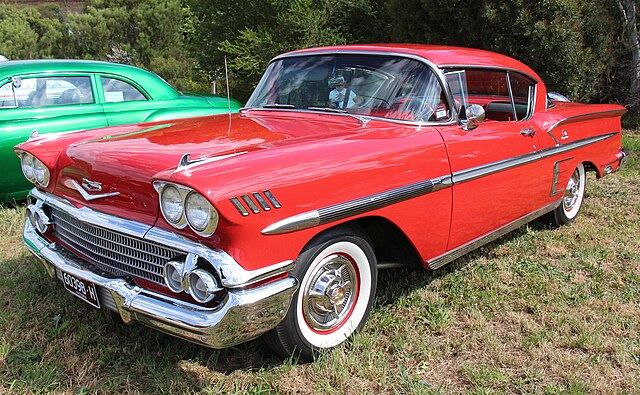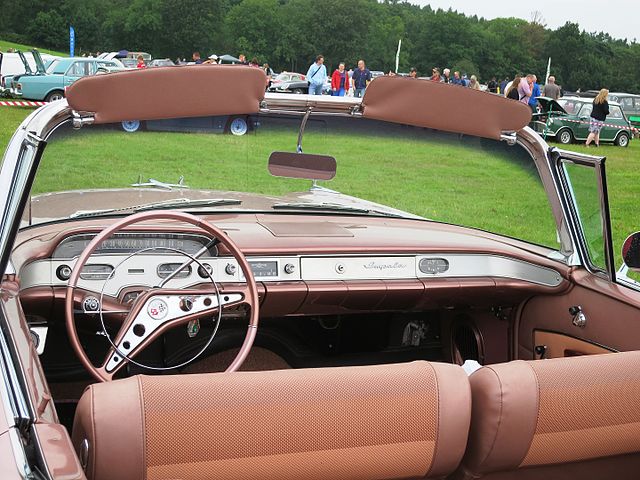
The Chevrolet Impala, introduced in 1958, quickly became a symbol of American automotive culture, known for its style, performance, and innovation. This article focuses on the first generation of the Impala, a model that set the tone for decades of design and technological advancements.
Here’s a deep dive into what made the 1958 Chevrolet Impala a standout model.
Introduction to the First Generation

The first generation Chevrolet Impala was launched in 1958 as a top-of-the-line model of the Chevrolet Bel Air series. This introduction marked a significant step for Chevrolet in competing against other luxury automobiles of the era.
The Impala was distinct in its styling and came with features that were advanced for its time, appealing to a post-war audience that was increasingly interested in both performance and luxury.
The 1958 Impala was specifically designed to be eye-catching, featuring a longer, lower, and wider stance than its predecessors. Its unique body styling included a distinctive grille, wide fins, and triple taillights that would become a signature feature for many Impala generations.
This model was available in several body styles, including a sedan, coupe, and convertible, each offering a spacious and comfortable interior that made it a popular choice among American families.
The model’s introduction not only signaled a shift towards more luxurious and stylish vehicles but also underscored Chevrolet’s commitment to innovation. It showcased a blend of engineering excellence and aesthetic appeal, setting a benchmark in the automotive industry.
Design and Styling

The 1958 Chevrolet Impala was renowned for its daring and dramatic styling, which was a significant departure from the more conservative designs of the early 1950s. The car featured a bold, aerodynamic look with its low-roofline and wide, flaring fins at the rear, which not only added to its visual impact but also enhanced its aerodynamic efficiency.
Inside, the Impala offered a lavish interior with premium materials and top-tier finishes. The dashboard was sleek and featured Chevrolet’s first use of a symmetrical instrument panel that was both functional and aesthetically pleasing. Rich upholstery options, including a choice between cloth and leather, along with a color-matched steering wheel, added to the luxurious feel of the car.
Chrome detailing was another standout feature, heavily used both inside and out. It highlighted the vehicle’s contours and emphasized its upscale positioning in the market. The Impala’s design elements, from the distinctive cross-flag emblems to the bright metal trim, set it apart from other models on the road and contributed significantly to its success.
Performance and Engineering

Under the hood, the 1958 Impala was just as impressive as it was visually. It came equipped with a variety of engine options, catering to both regular consumers and performance enthusiasts. The standard engine was a 235.5 cubic inch (3.9-liter) inline-six capable of producing 145 horsepower.
However, the real excitement lay in the optional V8 engines, including the 283 cubic inch (4.6-liter) and the 348 cubic inch (5.7-liter) V8, which could be equipped with multiple carburetors to boost power output significantly.
These engines were paired with either a manual three-speed transmission or the more popular two-speed Powerglide automatic transmission. For those looking for even more power, Chevrolet offered an optional three-speed manual with overdrive, providing impressive performance metrics for the era.
The Impala also featured advanced technology such as air suspension, which was a novelty at the time, offering a smoother ride and better handling.
Cultural Impact
The 1958 Chevrolet Impala quickly became an icon of American automotive culture, embodying the optimism and prosperity of the late 1950s. Its striking appearance and impressive performance made it popular among a wide range of consumers, from families to speed enthusiasts.
The Impala’s image was further enhanced by its appearances in movies, television shows, and other forms of media, cementing its status as a cultural symbol.
The car’s popularity also influenced the automotive industry, prompting other manufacturers to adopt similar designs and innovations. The Impala’s introduction of features such as the triple taillight arrangement became a stylistic staple for Chevrolet, influencing various future models.
Legacy and Collectibility
Today, the 1958 Chevrolet Impala is considered a highly collectible classic car. Its unique design and historical significance make it a favorite among classic car enthusiasts, and it frequently appears at car shows and auctions. The Impala’s legacy is reflected in its enduring popularity and the high regard in which it is held within the classic car community.
The model’s collectibility is enhanced by its relatively limited production run, making surviving examples especially valuable. Restored models, particularly convertibles with high-performance engines and original specifications, are highly sought after and command premium prices in the collector’s market.
In summary, the 1958 Chevrolet Impala represents a pivotal moment in the history of Chevrolet and the American automotive industry. Its introduction marked the beginning of a new era of style and performance, setting trends that would continue for decades to come.
